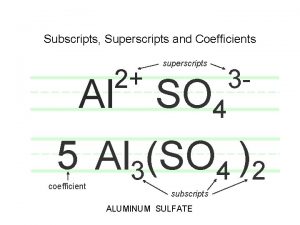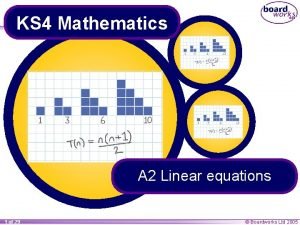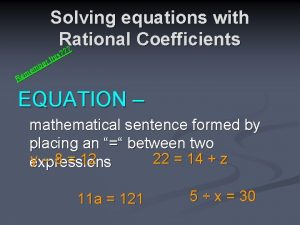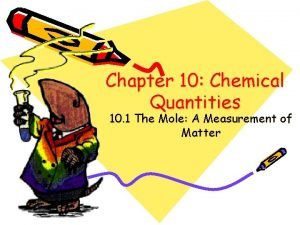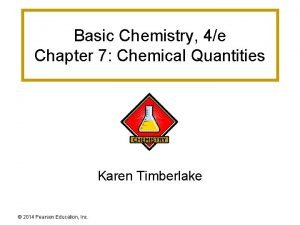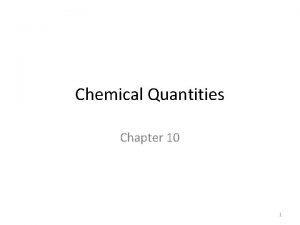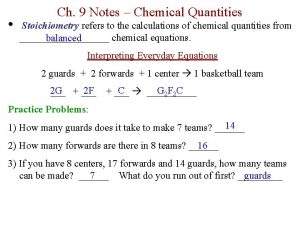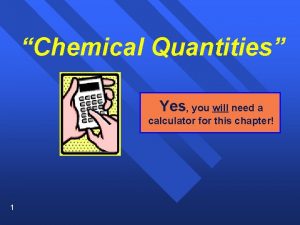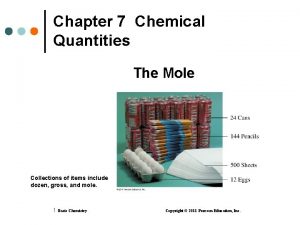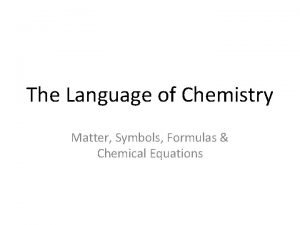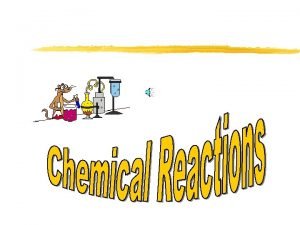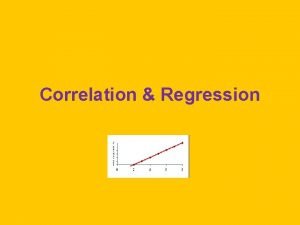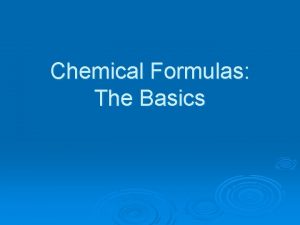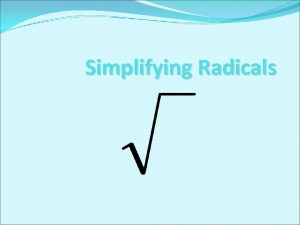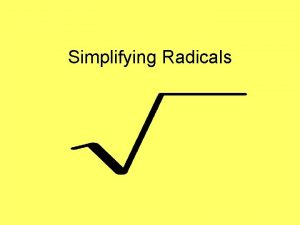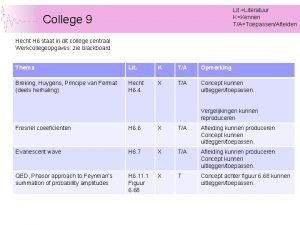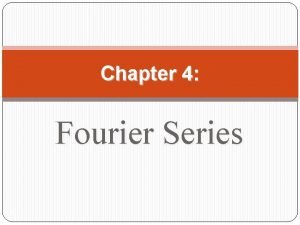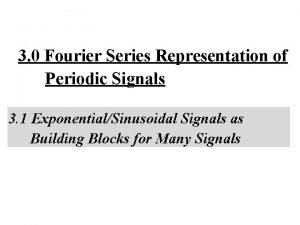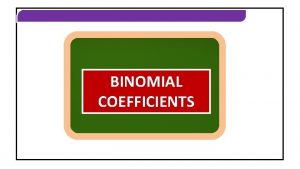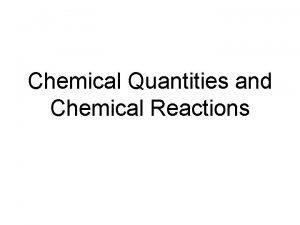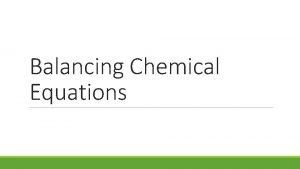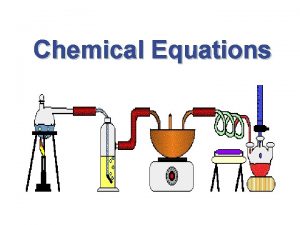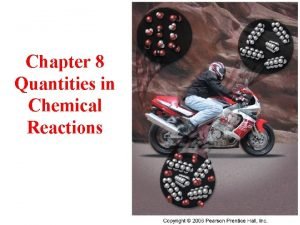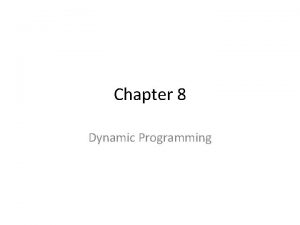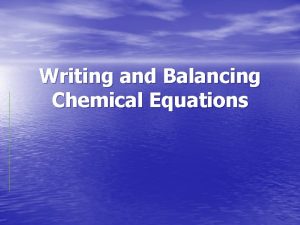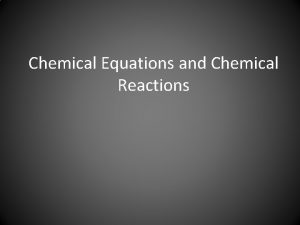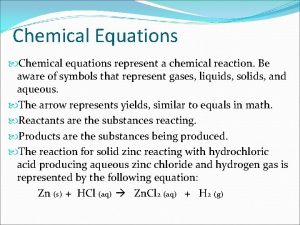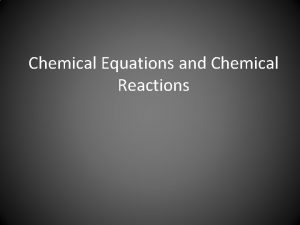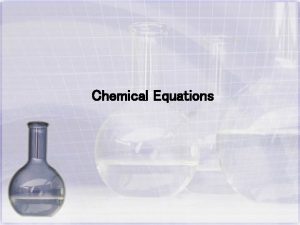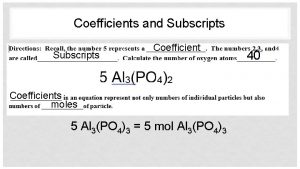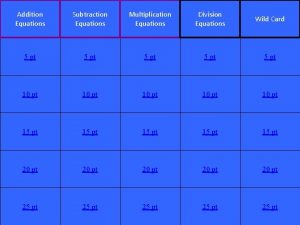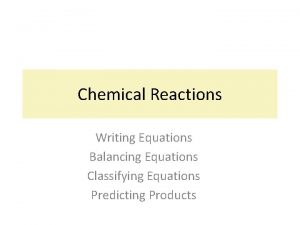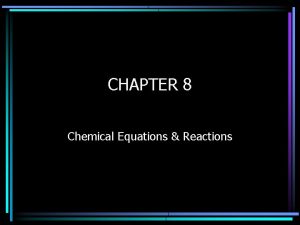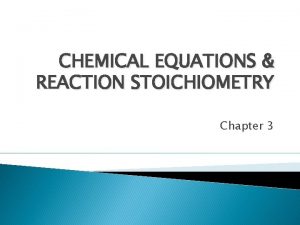CHEMICAL QUANTITIES Chapter 9 CHEMICAL EQUATIONS Coefficients in




































- Slides: 36

CHEMICAL QUANTITIES Chapter 9

CHEMICAL EQUATIONS • Coefficients in a balanced equations give us the relative number of molecules. • Amount of reactants determine the amount of products. • Need to focus on the ratio of coefficients, not just individual coefficients

REAL WORLD EXAMPLE • To make a hamburger, what would your need: • 1 bun • 1 hamburger patty • 4 slices of bacon • 1 slice of cheese • 2 pieces of lettuce • 3 slices of tomatoes • 5 pickle slices • 8 pieces of grilled onions • How would you figure out how much of each ingredients would you need if you were making 237 hamburgers?

REAL WORLD EXAMPLE • How would you figure out how much of each ingredients would you need if you were making 237 hamburgers? • 1 bun x 237 burgers = 237 buns • 1 hamburger patty x 237 burgers = 237 patties • 4 slices of bacon x 237 burgers = 948 slices of bacon • 1 slice of cheese x 237 burgers = 237 slices of cheese • 2 pieces of lettuce x 237 burgers = 474 pieces of lettuce • 3 slices of tomatoes x 237 burgers = 711 slices of tomatoes • 5 pickle slices x 237 burgers = 1185 pickle slices • 8 pieces of grilled onions x 237 burgers = 1896 pieces of grilled onion

REAL WORLD EXAMPLE • 237 Bn + 237 P + 948 Ba + 237 C + 474 L + 711 T +1185 P +1896 O = 237 HB • 1 Bn + 1 P + 4 Ba + 1 C + 2 L + 3 T + 5 P + 8 O = 1 HB • Notice the ratios • 237: 948: 237: 474: 711: 1185: 1896: 237 is the same as • 1: 1: 4: 1: 2: 3: 5: 8: 1

MOLECULES TO MOLES • Propane is used for backyard gas grills. Propane reacts with oxygen to release heat and carbon dioxide gas and water vapor. • Unbalanced equation: • C 3 H 8 (g) + O 2 (g) = CO 2 (g) + H 2 O (g) • Balanced equation: • C 3 H 8 (g) + 5 O 2 (g) = 3 CO 2 (g) + 4 H 2 O (g) • 1 molecule C 3 H 8 reacts with 5 molecules of O 2 to give 3 molecules of CO 2 and 4 molecules of H 2 O • from this we can say: • 1 mole C 3 H 8 reacts with 5 mole of O 2 to give 3 mole of CO 2 and 4 mole of H 2 O

PICK A CARD, ANY CARD… X ? P

USING WHAT WE KNOW • Methane burn in oxygen forming carbon dioxide and water. • CH 4 + 2 O 2 = CO 2 + 2 H 2 O • What number of moles of Oxygen is needed to react with 7. 4 moles methane? • 2 moles O 2 x 7. 4 moles CH 4 = 14. 7 moles O 2 1 mole CH 4 • • How many moles of carbon dioxide will be produced if you reacted 2. 6 moles of oxygen with excess methane? • 1 mole CO 2 x 2. 6 moles O 2 = 1. 3 moles CO 2 • 2 moles O 2

TABLE PROBLEMS • Calculate the number of moles of oxygen required to react exactly with 4. 3 moles of propane, given this reaction: • C 3 H 8 (g) + 5 O 2 (g) = 3 CO 2 (g) + 4 H 2 O (g) • 5 moles O 2 x 4. 3 moles C 3 H 8 = 21. 5 moles O 2 1 mole C 3 H 8 • Calculate the moles of CO 2 formed when 4. 3 moles C 3 H 8 reacts with the 21. 5 moles O 2. • 3 moles CO 2 x 4. 3 moles C 3 H 8 = 12. 9 moles CO 2 1 mole C 3 H 8

MASS CALCULATIONS • Given the following equation, how much iodine is needed if we have 35 g of aluminum? • 2 Al + 3 I 2 = 2 Al. I 3 • We need to find number of moles of Al and grams of I 2. grams • 1 moles Al x 35 grams Al = 1. 297 moles Al 26. 982 g Al 3 moles I 2 x 1. 297 moles Al = 1. 9455 moles I 2 2 moles Al 253 grams I 2 x 1. 9455 moles I 2 = 493. 78 grams I 2 1 mole I 2 From PT 1 mole Al = 26. 982

PICK A CARD, ANY CARD… X ? P

PROBLEMS FOR YOU… • Calculate the mass of carbon dioxide required to react with 10. 0 grams of sodium hydroxide. • 2 Na. OH + CO 2 = Na 2 CO 3 + H 2 O • 44. 01 grams CO 2 x 1 mole CO 2 x 1 mole Na. OH x 10 grams Na. OH = 5. 50 grams CO 2 • 1 mole CO 2 2 moles Na. OH 39. 998 grams Na. OH • Determine the mass of O 2 required to react with 96. 1 grams C 3 H 8. • C 3 H 8 (g) + O 2 (g) = CO 2 (g) + H 2 O (g) • 32 grams O 2 x 1 mole C 3 H 8 x 96. 1 grams C 3 H 8 = 69. 742 grams O 2 • 1 mole O 2 1 mole C 3 H 8 44. 094 grams

USING STOICHIOMETRY TO COMPARE REACTIONS • Compare Baking soda (Na. HCO 3) and milk of magnesia (Mg(OH)2 in neutralizing stomach acid. You have 1 g of each Na. HCO 3 and Mg(OH)2. • Na. HCO 3 + HCl = Na. Cl + H 2 O + CO 2 • Mg(OH)2 + 2 HCl = 2 H 2 O + Mg. Cl 2 • 1 moles HCl x 1 mole Na. HCO 3 x 1 gram Na. HCO 3 = 0. 0119 moles HCl • 1 mole Na. HCO 3 84. 008 gram Na. HCO 3 • 2 mole HCl x 1 mole Mg(OH)2 x 1 g Mg(OH)2 = 0. 0343 moles HCl • 1 mole Mg(OH)2 58. 321 grams Mg(OH)2

LIMITING REACTANTS • To make a hamburger, what would your need: • Suppose you have leftover from the BBQ, • 1 bun • 19 buns • 1 hamburger patty • 43 hamburger patties • 4 slices of bacon • 75 slices of bacon • 1 slice of cheese • 34 slices of cheese • 2 pieces of lettuce • 48 pieces of lettuce • 3 slices of tomatoes • 62 slices of tomatoes • 5 pickle slices • 102 pickle slices • 8 pieces of grilled onions • 160 pieces of grilled onions How many burgers can you make before you run out of

LIMITING REACTANTS • Buns – 19 • Patties – 19 with 24 left over • Bacon – 18 with 3 left over • Cheese – 19 with 15 left over • Lettuce – 19 with 10 left over • Tomato – 19 with 5 left over • Pickle – 19 with 7 left over • Onion – 19 with 8 left over • We run out of bacon before all the other ingredients – this is our limiting reactant!

USING WHAT WE LEARNED • The reactant that runs out first and “limits” the amount of products that can form are called limiting reactants or limiting reagents.

STEPS FOR CALCULATING LIMITING REACTANTS • 1. Balance the equation. • 2. Convert masses of reactants or products to moles. • 3. Use balanced equation to get mole ratio. • 4. Use mole ratio to calculate number of moles of desired reactant or product. • 5. Convert mole back to mass.

IDENTIFYING LIMITING REACTANTS • Suppose 25 kg of nitrogen gas and 5 kg of hydrogen gas are mixed and react to form ammonia. Calculate the mass of ammonia produced. • 1. Write a balanced equation. • N 2 + 3 H 2 = 2 NH 3 • 2. Convert mass to moles • 1 mole N 2 x 1000 g x 25 kg = 892 moles N 2 • 28. 02 gr 1 kg • 1 mole H 2 x 1000 gr x 5 kg = 2480 moles H 2 • 2. 016 gr 1 kg

IDENTIFYING LIMITING REACTANTS • Suppose 25 kg of nitrogen gas and 5 kg of hydrogen gas are mixed and react to form ammonia. Calculate the mass of ammonia produced. • 3. Use the balanced equations to get molar ratios. N 2 + 3 H 2 = 2 NH 3 • 4. Use the molar ratios to calculate reactants or products. • 3 mole H 2 x 892 moles N 2 = 2680 moles H 2 • 1 mole N 2 • So we need 2680 moles H 2 but we only have 2480 moles H 2. So H 2 is the limiting reactant. • 2 moles NH 3 x 2480 moles H 2 = • 3 moles H 2 1650 moles NH 3

IDENTIFYING LIMITING REACTANTS • Suppose 25 kg of nitrogen gas and 5 kg of hydrogen gas are mixed and react to form ammonia. Calculate the mass of ammonia produced. • 5. Convert moles into mass. N 2 + 3 H 2 = 2 NH 3 • 17. 03 g NH 3 x 1650 moles NH 3 = 2810 grams NH 3 • 1 mole NH 3

PICK A CARD, ANY CARD… X ? P

YOUR TURN. . • Aluminum reacts with chlorine to form aluminum chloride. You have 10 grams of aluminum and 35 grams of chlorine. How many grams of Al. Cl 3 will be produced? • • • 1. Write a balanced equation. 2 Al + 3 Cl 2 = 2 Al. Cl 3 2. Convert mass to moles 1 mole Al x 10 g =. 3706 moles Al 26. 98 gr • 1 mole Cl 2 x 35 gr =. 4936 moles Cl 2 • 70. 9 gr

YOUR TURN. . • Aluminum reacts with chlorine to form aluminum chloride. You have 10 grams of aluminum and 35 grams of chlorine. How many grams of Al. Cl 3 will be produced? • 3. Use the balanced equations to get molar ratios. 2 Al + 3 Cl 2 = 2 Al. Cl 3 • 4. Use the molar ratios to calculate reactants or products. • 2 mole Al x. 4936 moles Cl 2 =. 3290 moles Al • 3 mole Cl 2 • 3 moles Cl 2 x. 3706 gr Al =. 5559 moles Cl 2 • 2 mole Al • So we need. 3290 moles Al &. 5559 Cl 2 moles Cl 2, but we only have. 3706 Al and. 4937 moles Cl 2. So Cl 2 is the limiting reactant.

YOUR TURN. . • Aluminum reacts with chlorine to form aluminum chloride. You have 10 grams of aluminum and 35 grams of chlorine. How many grams of Al. Cl 3 will be produced? • 5. Convert moles into mass. 2 Al + 3 Cl 2 = 2 Al. Cl 3 • 133. 332 gr Al. Cl 3 x 2 moles Al. Cl 3 x. 4937 moles Cl 2 = 43. 88 grams Al. Cl 3 1 mole Al. Cl 3 3 moles Cl 2

YOUR TURN. . • Aluminum reacts with chlorine to form aluminum chloride. You have 10 grams of aluminum and 35 grams of chlorine. How many grams of Al left over? • 2 Al + 3 Cl 2 = 2 Al. Cl 3 • 26. 982 gr Al x 2 moles Al x. 4937 moles Cl 2 = 8. 88 grams Al 1 mole Al 3 moles Cl 2 • But since we started with 10 grams, • 10 – 8. 88 = 1. 12 grams Al left over

PICK A CARD, ANY CARD… X ? P

PERCENT YIELD • Theoretical yield – amount of product calculated to result from a given equation (what we did last section!) • maximum amount available to be produced from the given reactants. • Unfortunately, this yield is rarely attained! • Percent yield – actual yield of products, actual amount of products produced. • Tells the efficiency of the reaction. • Actual yield x 100% = percent yield • Theoretical Yield

CALCULATING PERCENT YIELD • Suppose 68. 5 kg of CO is reacted with 8. 6 kg of H 2. Calculate theoretical yield of the reaction. 2 H 2 + CO = CH 3 OH • 1. Write a balanced equation. 2 H 2 + CO = CH 3 OH • 2. Convert mass to moles • 1 mole CO x 1000 g x 68. 5 kg = 2445. 55 mole CO • 28. 01 g CO 1 kg • 1 mole H 2 x 1000 g x 8. 6 kg = 4282. 87 mole H 2 • 2. 008 g 1 kg

CALCULATING PERCENT YIELD • Suppose 68. 5 kg of CO is reacted with 8. 6 kg of H 2. Calculate theoretical yield of the reaction. 2 H 2 + CO = CH 3 OH • 3. Use the balanced equations to get molar ratios. • 4. Use the molar ratios to calculate reactants or products • 2 mole H 2 x 2445. 55 moles CO = 4891. 1 mole H 2 • 1 mole CO • But since we only have 4282. 87 mole H 2 but we need 4891. 1 mole H 2. • H 2 is the limiting reactant.

CALCULATING PERCENT YIELD • Suppose 68. 5 kg of CO is reacted with 8. 6 kg of H 2. Calculate theoretical yield of the reaction. 2 H 2 + CO = CH 3 OH • 4. Use the molar ratios to calculate reactants or products • 32. 042 grams CH 3 OH x 1 mole CH 3 OH x 4282. 87 mole H 2 = 68615. 86 grams CH 3 OH • 1 mole CH 3 OH yield. ) 2 moles H 2 (This is theoretical • If 35. 7 kg of methanol produced, what is the percent yield? • 35. 7 kg x 100% = 52. 03 %

PICK A CARD, ANY CARD… X ? P

TABLE TALK • Solid titanium (iv) oxide can be prepared by reacting gaseous titanium (IV) chloride with oxygen. A second product of this reaction is chlorine gas. If 6. 71 kg of titanium (IV) chloride is reacted with 2. 45 kg of oxygen. • A. Calculate theoretical yield of titanium (IV) oxide. • B. If the percent yield is 75%, how much titanium (IV) oxide is produced? • 1. Write a balanced equation. • Ti. Cl 4 + O 2 = Ti. O 2 + 2 Cl 2 • 2. Convert mass to moles • 1 mole Ti. Cl 4 x 6710 g = 35. 378 moles Ti. Cl 4 moles O 2 • 189. 667 g 1 mole O 2 x 2450 g = 76. 56 32. 0 g

TABLE TALK • Solid titanium (iv) oxide can be prepared by reacting gaseous titanium (IV) chloride with oxygen. A second product of this reaction is chlorine gas. If 6. 71 kg of titanium (IV) chloride is reacted with 2. 45 kg of oxygen. • A. Calculate theoretical yield of titanium (IV) oxide. • B. If the percent yield is 75%, how much titanium (IV) oxide is produced? • 3. Use the balanced equations to get molar ratios. Ti. Cl 4 + O 2 = Ti. O 2 + 2 Cl 2 • 4. Use the molar ratios to calculate reactants or products • 1 mole Ti. Cl 4 x 76. 56 = 76. 56 • 1 mole O 2 but we only have 35. 378 moles Ti. Cl 4

TABLE TALK • Solid titanium (iv) oxide can be prepared by reacting gaseous titanium (IV) chloride with oxygen. A second product of this reaction is chlorine gas. If 6. 71 kg of titanium (IV) chloride is reacted with 2. 45 kg of oxygen. • A. Calculate theoretical yield of titanium (IV) oxide. • B. If the percent yield is 75%, how much titanium (IV) oxide is produced? • 3. Use the balanced equations to get molar ratios. Ti. Cl 4 + O 2 = Ti. O 2 + 2 Cl 2 • 4. Use the molar ratios to calculate reactants or products • 1 mole Ti. Cl 4 x 76. 56 = 76. 56 • 1 mole O 2 but we only have 35. 378 moles Ti. Cl 4

TABLE TALK • If 6. 71 kg of titanium (IV) chloride is reacted with 2. 45 kg of oxygen. Ti. Cl 4 + O 2 = Ti. O 2 + 2 Cl 2 • A. Calculate theoretical yield of titanium (IV) oxide. • B. If the percent yield is 75%, how much titanium (IV) oxide is produced? • • • 4. Use the molar ratios to calculate reactants or products 79. 867 g Ti. O 2 x 1 mole Ti. O 2 x 35. 378 moles Ti. Cl 4 = 2825. 53 grams Ti. O 2 1 mole Ti. Cl 4 Actual yield x 100% = percent yield 2119. 148 gr • Theoretical yield AY x 100% = 75% 2825. 53 AY =

WORKS CITED • https: //encrypted-tbn 0. gstatic. com/images? q=tbn: ANd 9 Gc. Sy 3 m. S 4 hr. Sb 4 N-w 8 -OF 9 YBOGw 3 s. VPga_N-n 4 ntbp-vk. DQ 38 ec. E • https: //www. learner. org/courses/chemistry/images/lrg_img/methane_rxn. jpg • https: //i. ytimg. com/vi/d. PBSQMc 6 dn. Q/maxresdefault. jpg • http: //wps. prenhall. com/wps/media/objects/165/169519/GIFS/AAAUAUT 0. JPG • https: //d 2 gne 97 vdumgn 3. cloudfront. net/api/file/BWc. Rc 9 id. QQCclt. Py. NO 7 l • https: //ssc. oureducation. in/wp-content/uploads/2017/06/quiz-940 x 530 -704 x 400. jpg • https: //whitespark. ca/wp-content/uploads/2016/01/review-handout-generator-1. jpg
 Chemical formula
Chemical formula The calculations of quantities in chemical reactions
The calculations of quantities in chemical reactions Stoichiometry review answers
Stoichiometry review answers Relation between linear velocity and angular velocity
Relation between linear velocity and angular velocity Solving equations with fractional coefficients
Solving equations with fractional coefficients Solving equations with fractional coefficients
Solving equations with fractional coefficients Solving linear equations with rational coefficients
Solving linear equations with rational coefficients Are kc and kp equal
Are kc and kp equal Label an atom
Label an atom Chemistry chapter 10 chemical quantities
Chemistry chapter 10 chemical quantities Chapter 7 chemical quantities answer key
Chapter 7 chemical quantities answer key Chapter 10 chemical quantities
Chapter 10 chemical quantities Chapter 10 chemical quantities practice problems answer key
Chapter 10 chemical quantities practice problems answer key Chapter 9 chemical quantities
Chapter 9 chemical quantities Translate word equations to chemical equations
Translate word equations to chemical equations Chemical quantities calculator
Chemical quantities calculator Unit chemical quantities the mole 1 step
Unit chemical quantities the mole 1 step Chapter 8 review chemical equations and reactions
Chapter 8 review chemical equations and reactions Chapter 8 section 1 chemical equations and reactions
Chapter 8 section 1 chemical equations and reactions Balancing equations chapter 8
Balancing equations chapter 8 Synthesis reaction
Synthesis reaction Language of chemistry
Language of chemistry T=2π
T=2π Equating coefficients
Equating coefficients Combustion reaction examples
Combustion reaction examples Unstandardized coefficients
Unstandardized coefficients Sample of literal coefficient
Sample of literal coefficient Coefficient and subscript
Coefficient and subscript Addition in angular
Addition in angular Standardized canonical discriminant function coefficients
Standardized canonical discriminant function coefficients Clebsch gordan coefficients
Clebsch gordan coefficients Gregory coefficients
Gregory coefficients How to add square roots with coefficients
How to add square roots with coefficients 9/16 simplified
9/16 simplified Fresnel coefficients
Fresnel coefficients Fourier series equation
Fourier series equation Series representation
Series representation
